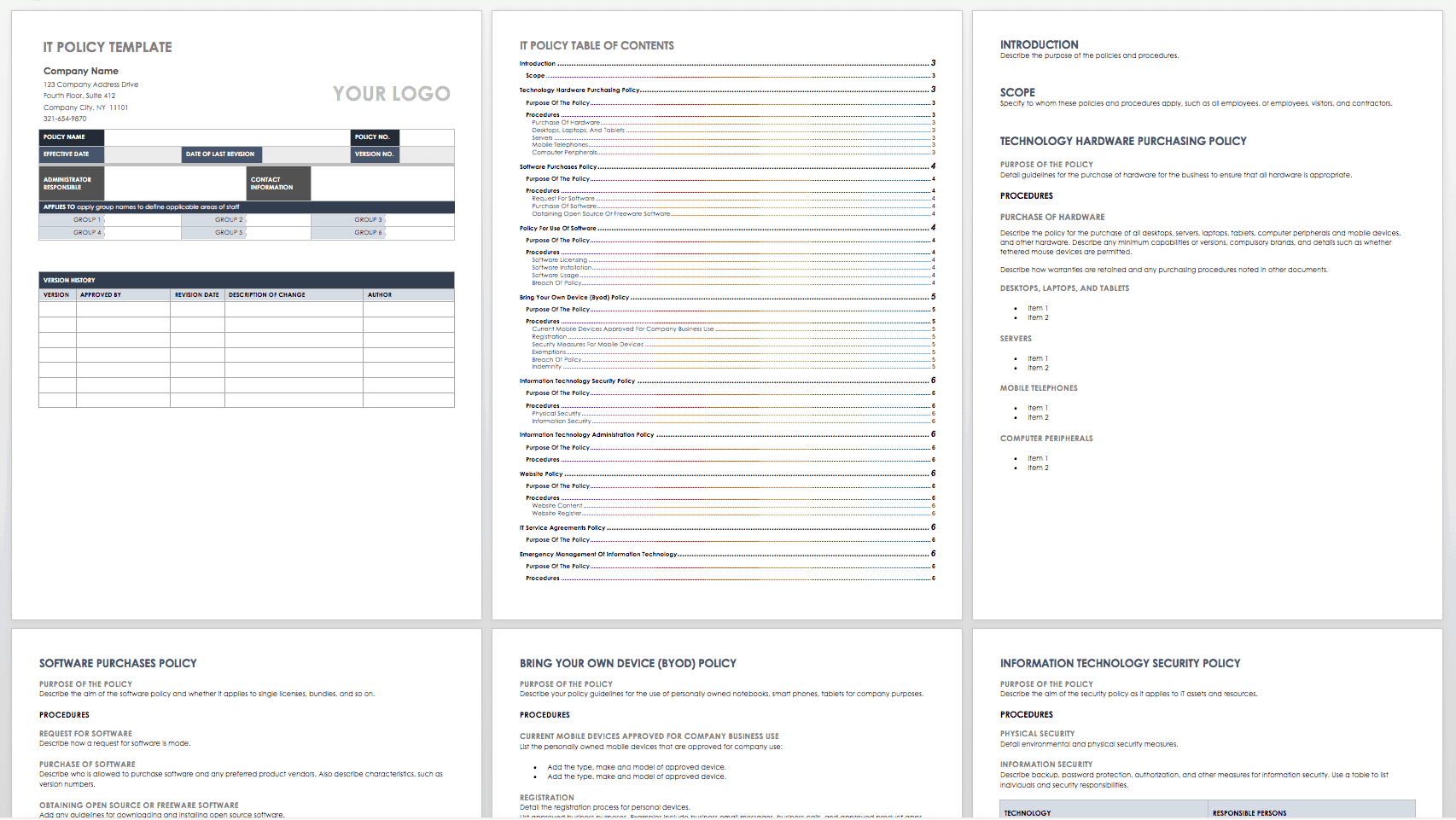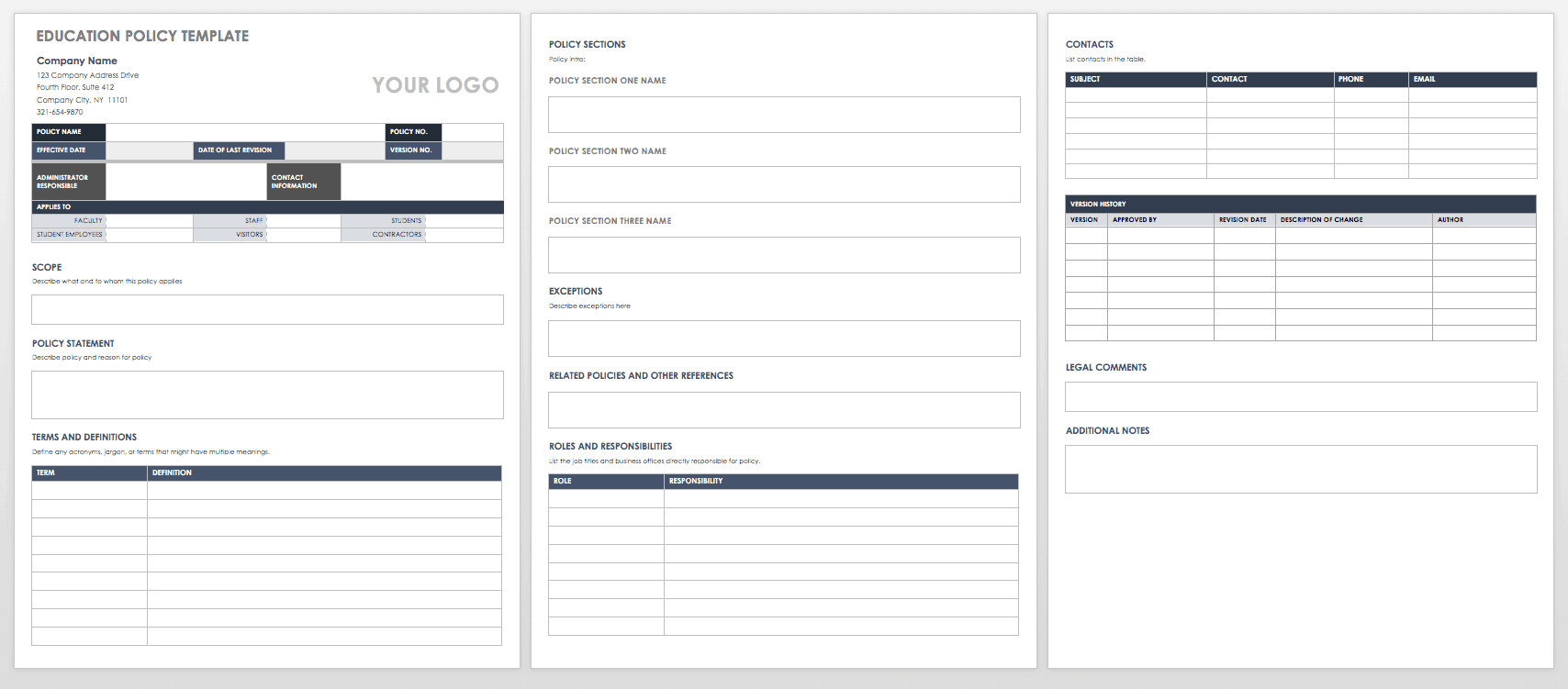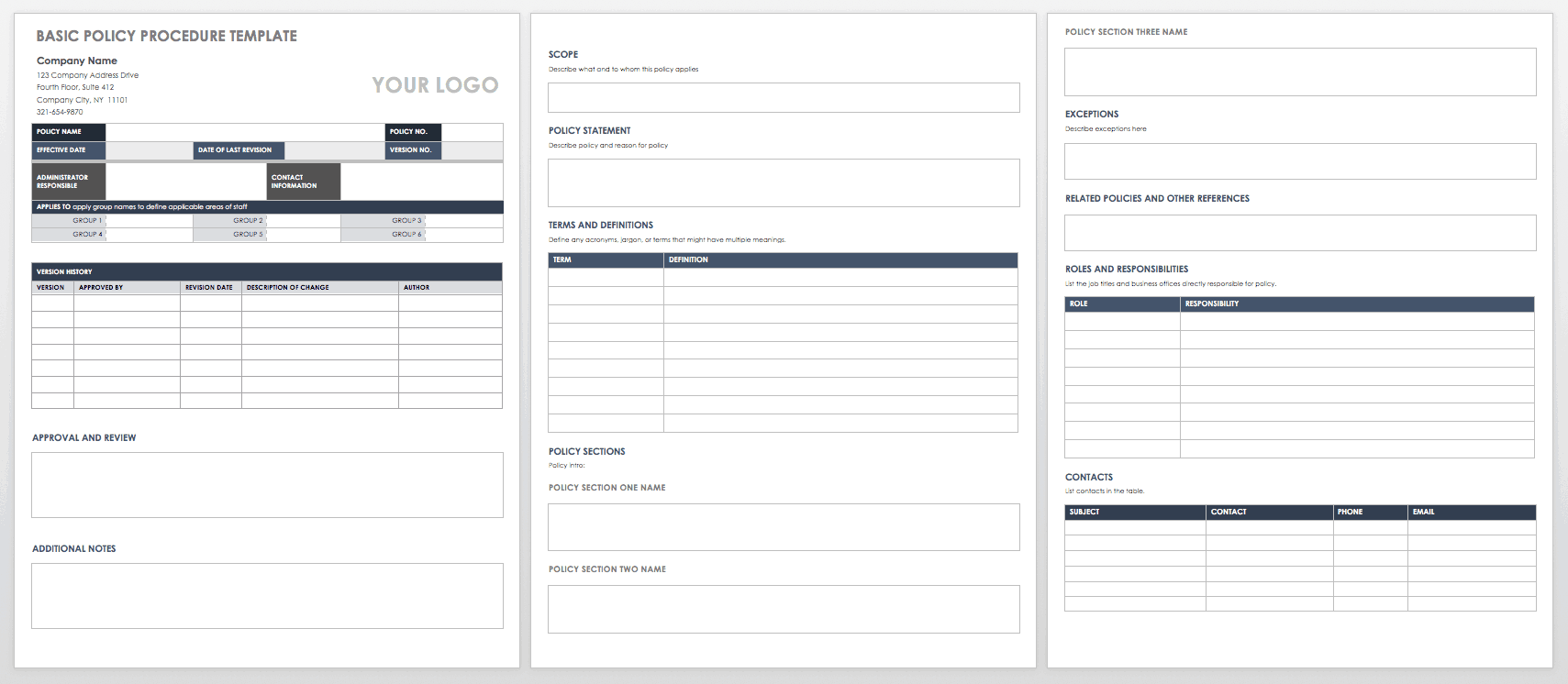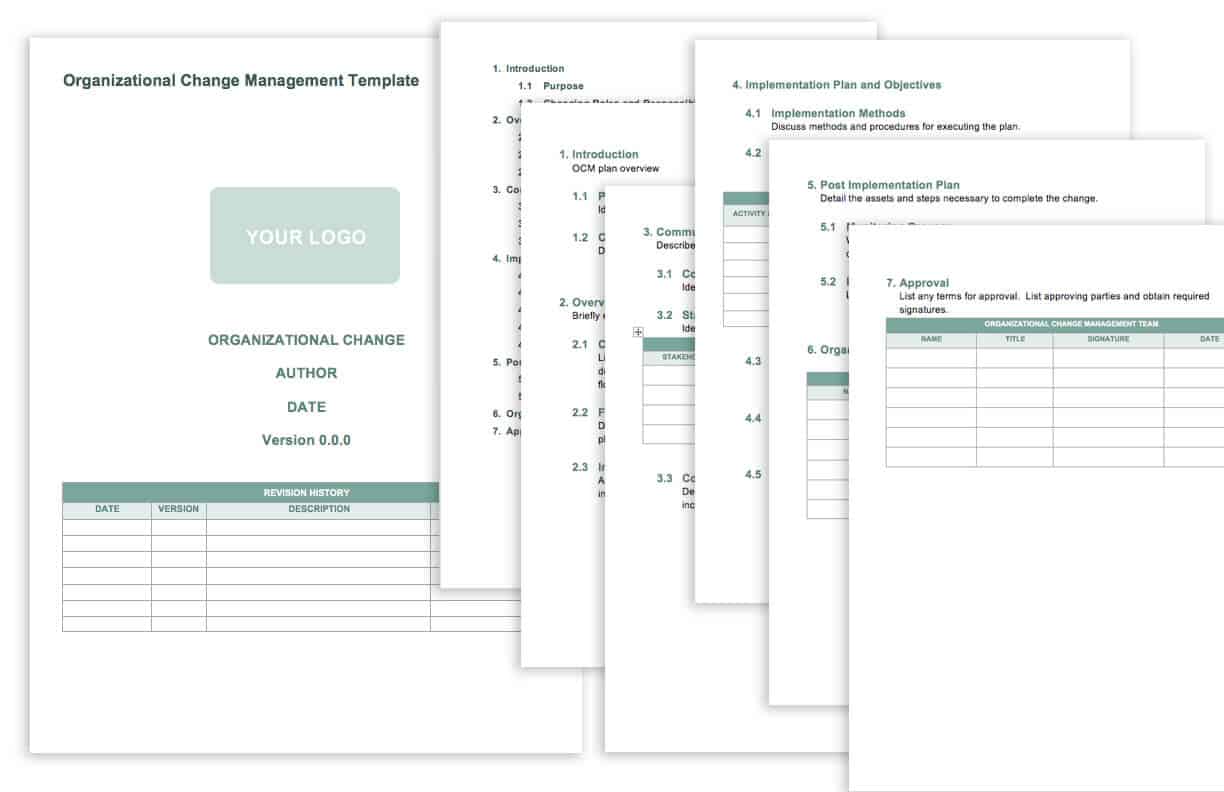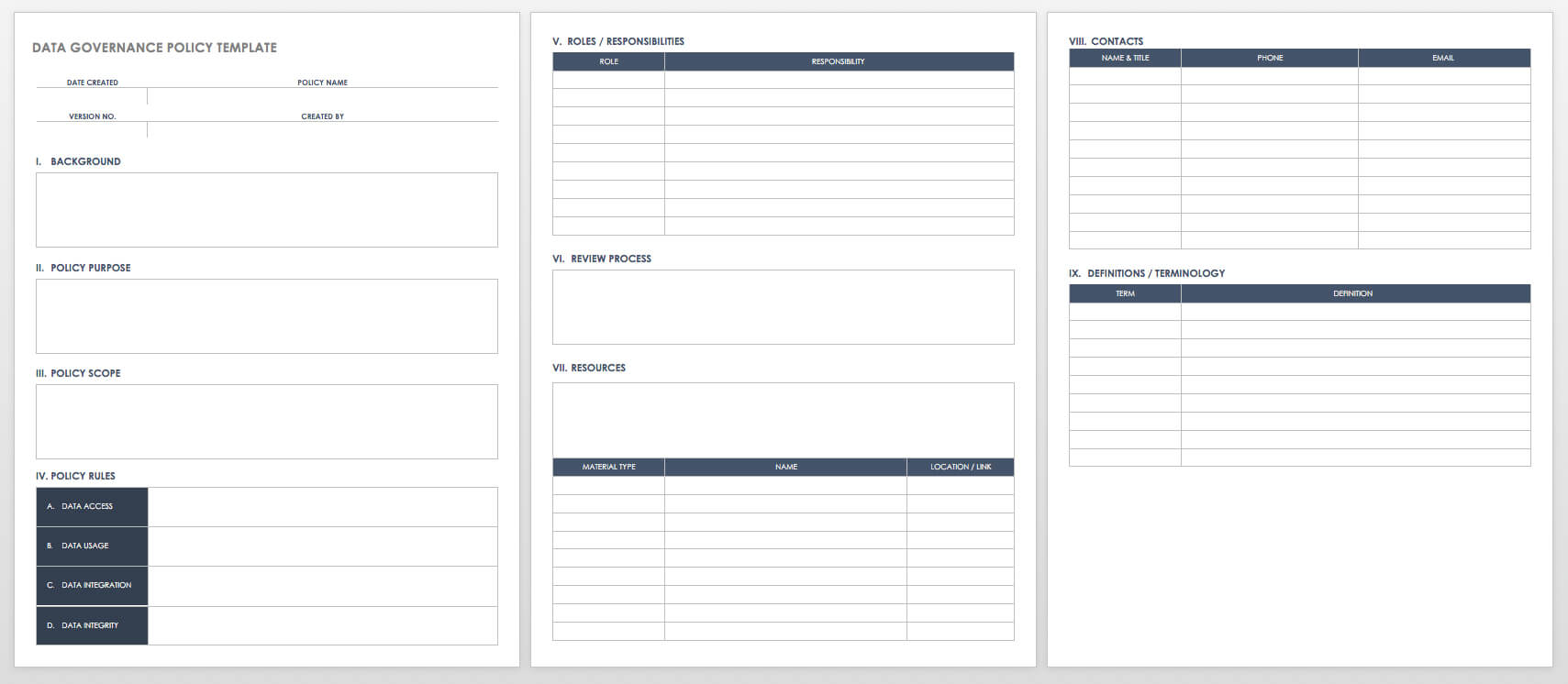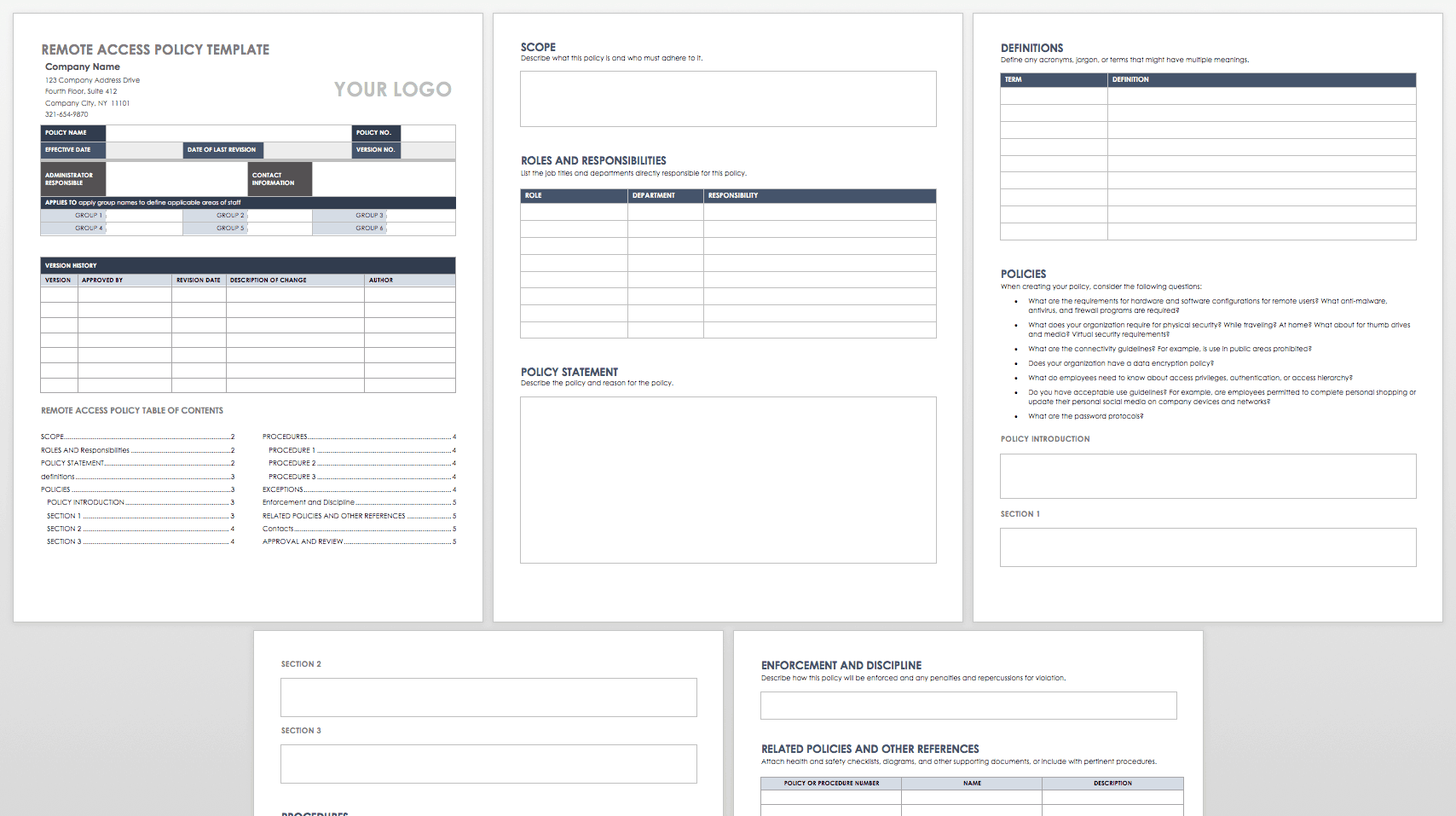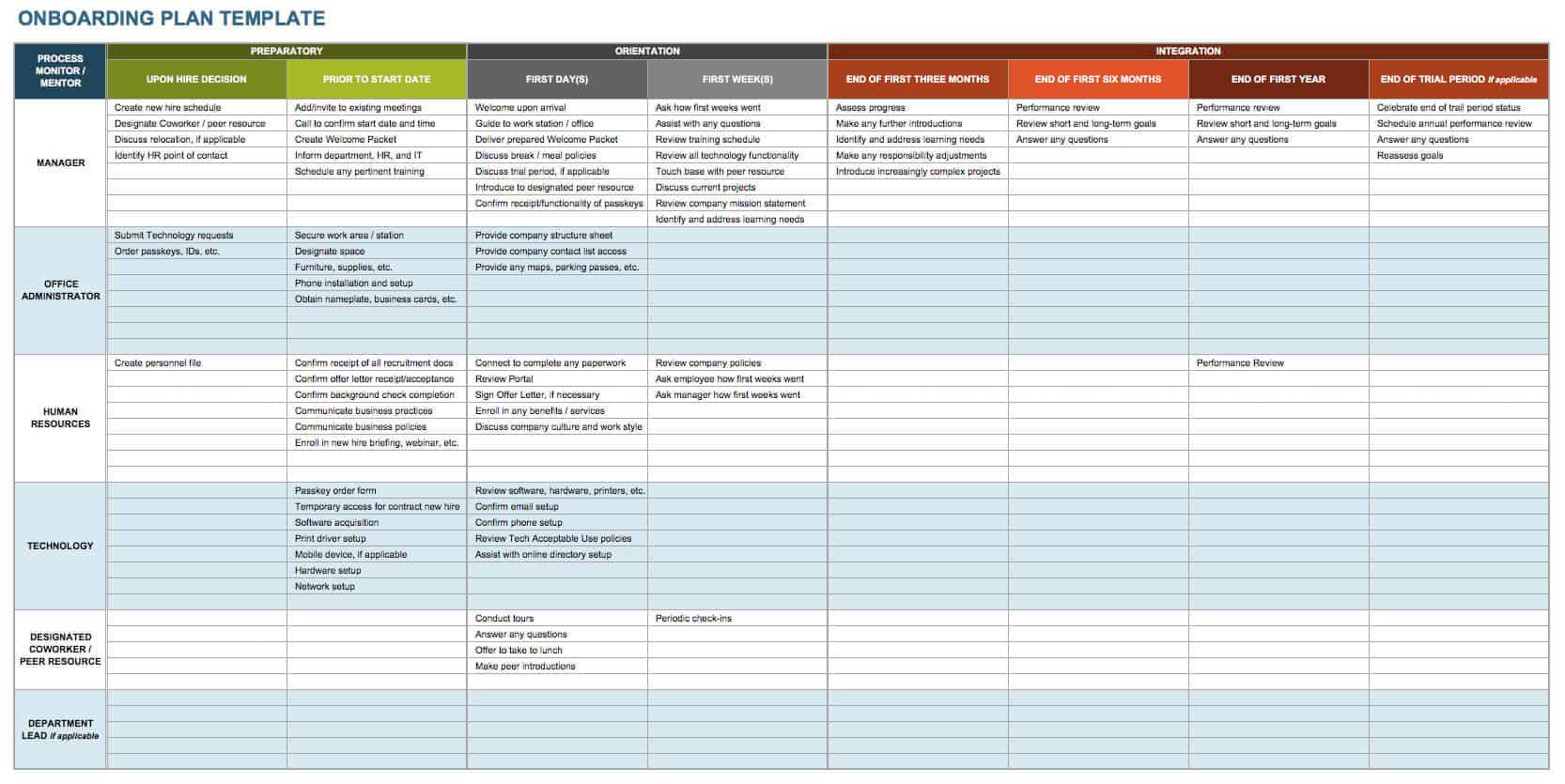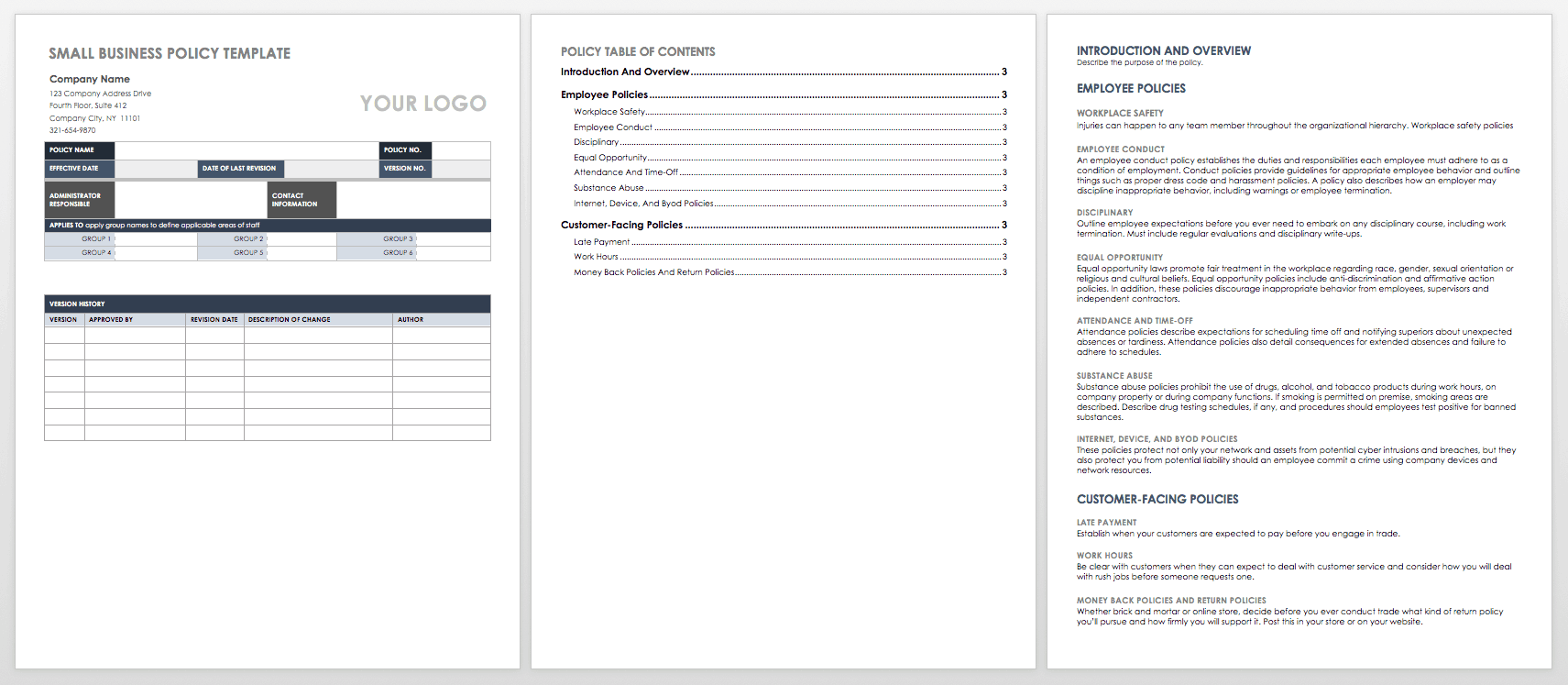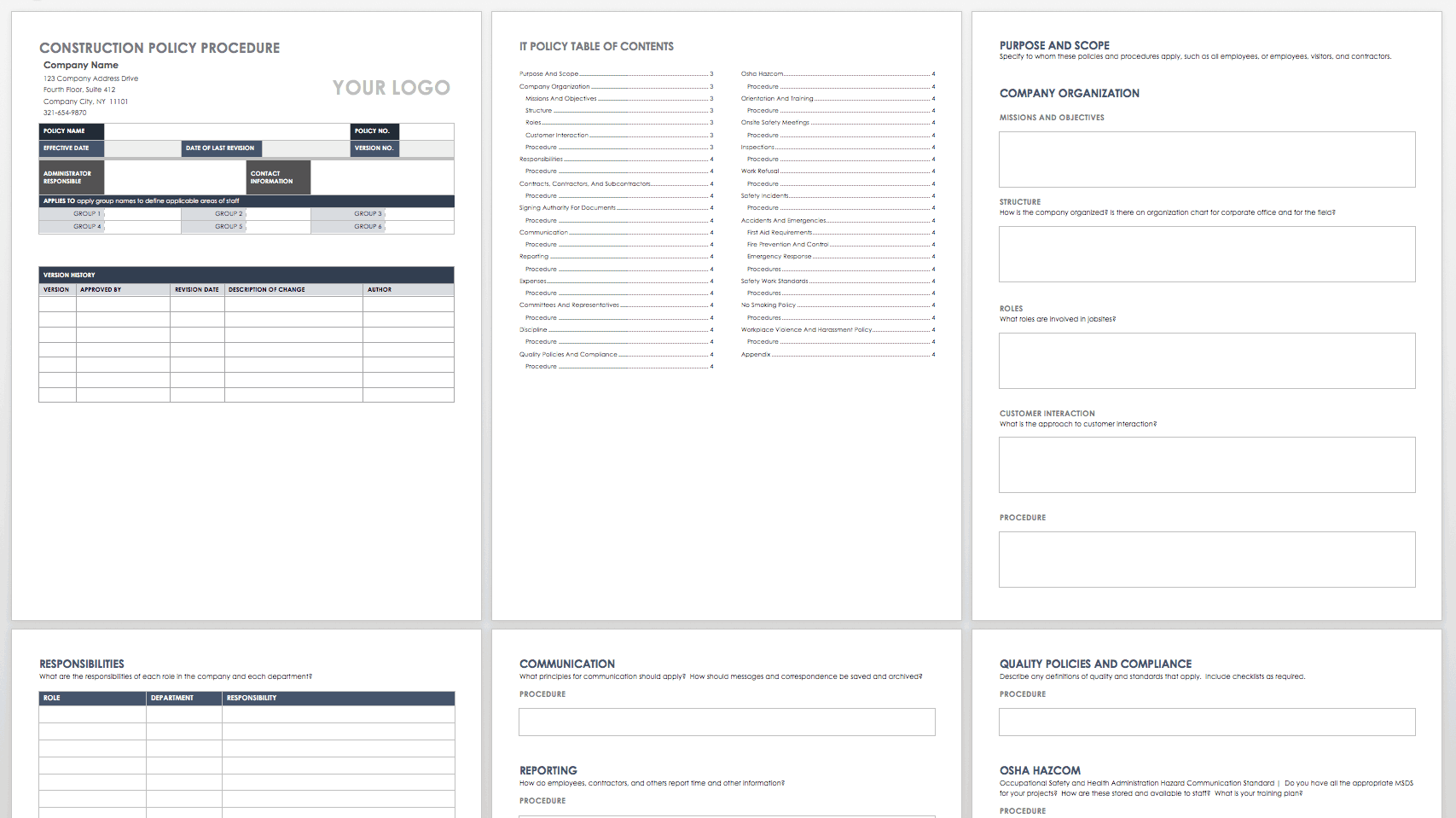Sample Policy and Procedure Templates
Professional associations and government departments frequently publish policies and procedures as well as sample templates (for example, consider these tips for nonprofits and small businesses). Search online for samples that may be pertinent to your industry.
You can also use a template to save time and effort. Below you’ll find nine free, downloadable, use-case specific templates to get started.
IT Policy and Procedure Template
Download Word Template
Try Smartsheet Template
Clearly defined IT policies and procedures can prevent privacy and data breaches. After an IT security event, policies can aid in disaster recovery. Depending on the size of your organization, you may have one document or several documents. Consider adding guidance and steps to this Word template for software and hardware purchases and approved models and versions. Add your own device, visitor policy, password policy, security events, and any considerations pertinent to your company or organization.
Education Administration Policy and Procedure Template
Higher education policies and procedures can apply to different groups, including staff, students, and visitors. Policies can set expectations for aspects of the job (such as behavior and course quality, or for tangibles (what equipment can be purchased, from what vendors, and with what process). Your institution may publish its own templates and style guide on its website. Use this template in Word to determine your needs.
Basic Policy and Procedure Template
Download Basic Policy and Procedure Template - Word
This is a basic policy and procedure template that you can customize to include the sections and content best suited to your organization. The table of contents section will update as you add to the content in the rest of the document— simply click Update Table in the Table of Contents group on the References tab.
Change Management Policy Template
Download Change Management Policy Template - Word
Managing change can be critical to the efficiency and success of your business. With this change management policy template in Word, you can describe the change, its scope, and the roles involved in the change. Detail change management risks, policies, and procedures.
Data Governance Policy Template
Download Data Governance Policy Template - Word
This data governance policy template can be a crucial part of building policy for your organization. Data governance helps you figure out who has access to your data, your data usage particulars, how data is integrated, and how data is protected.
Key Remote Access Policy Elements Template
Download Key Remote Access Policy Elements Template - Word
Increasingly, employees and other contributors wish to work off site or remotely. While this practice may enhance employee productivity, it presents extra considerations for network and data security. Use this checklist in Word to draft a remote access policy. Considerations include devices used remotely, locations of use, such as home or public areas, secure work areas, and more.
Onboarding Process Template
Download Onboarding Process Template - Excel
Onboarding, the process of bringing a new employee into an organization, can start with the recruiting process and continue well beyond the initial hiring — for example, to include notifying IT about access requirements and explaining company culture. This onboarding process template describes what to consider before an employee starts as well as what to think about during their first day, week, month, and at their three-month review.
Small Business Policy and Procedure Template
Download Small Business Policy and Procedure Template - Word
Even if you only employ a few workers, you are still responsible for their safety and well-being as well as the security and maintenance of material assets. Customize this small business policy and procedure template in Word to suit your company. Be sure to consider policies and procedures that cover such things as harassment, non-discrimination, workplace safety, smoking and alcohol or drug use, and IT best practices and security.
Construction Policy and Procedure Template
Download Construction Policy and Procedure Template - Word
One of the key aims of construction policies and procedures is to ensure worksite safety. Construction documentation provides for such things as employee safety training, inspections for hazards, and managing emergencies. Complete this template and train all employees in its provisions so all staff are prepared before an incident occurs.
What Is a Policy?
A policy provides guidelines and overall direction for an organization. Policies offer structure for consistency, and also ensure compliance with organizational values and goals as well as regulations and standards. Policies are generally set by upper management. A policy document should describe what the policy does and why it is necessary. It should also explain which individuals, roles, or departments are responsible for writing, reviewing, implementing, and managing the policy.
What Is a Procedure?
A procedure describes how policies should be implemented. Procedures are usually performed by employees and describe who should perform specific activities and how to complete a task.
What Is a Process?
A policy sets the overall tone for your company, and a procedure describes the steps employees should take to enact a specific policy. By contrast, a process describes how procedures across the entire company align with one another in order to realize a product or service. Processes should also detail who is responsible, and ensure that the necessary tasks are completed properly and on time.
What Separates Policies and Procedures?
Rendering policies and procedures distinct from one another is important, but combining a policy with a related procedure in the same document may be desirable for ease of reference. Policies provide a structure that can define your organization’s culture, and well-defined policies can offer a path to achieving long-term goals and even pursuing continual improvement. Policies can also help your organization reduce or avoid risk. In addition, policies can guide the way to regulatory compliance. Procedures show the steps that employees must take to implement those policies. They can give clear guidance on what to do in particular sets of circumstances in order to avoid improvising solutions.
How to Write Effective Policies and Procedures
Policies and procedures can take a long time to develop and perfect, but you can expedite the experience by following a few developmental and structural steps. Policy and procedure templates can help. Your field or industry may publish templates, and purpose-built templates in manuals are sold online, sometimes for upwards of $550, depending on the complexity of the template. Software template bundles can cost in the $3000s.
Here are the major steps for writing effective policies and procedures:
- Preparing to Write: You can make your policy and procedure-writing process more efficient by treating the activity as a project and ensuring you get management support. That way, time and resources will be available to you. Because policies and procedures often involve legal and regulatory consequences, consider having documents reviewed by legal counsel.
Having a clear understanding of why a policy is necessary is also vital to keeping the project focused. Choosing an appropriate template for your field or industry will help you gain a better understanding of what content you need to add, and can also relieve you of the need to design a template. Moreover, if your organization has the means, a document management and tracking system can help you track revisions and publish the document in a place that is accessible to those who need it.
- Writing Your Documents: To write your documents, begin by reading current policies and procedures, if any exist. Also, review any compliance or regulatory guidelines that apply. Especially when creating procedures, it’s essential to consult the people who will use the procedures and perform the work, so they understand the steps in a workflow. Consulting employees on the creation of documentation is one of the best methods for ensuring their interest in and use of procedures.
After you draft the document, verify its accuracy by walking through the steps. Have those affected by the document evaluate the document. Finally, get approval for and sign off on the document from the highest level of management you can, such as a CTO or CEO.
- Implementing Policies and Procedures: To encourage the success of a document, plan its implementation. Publish the document in one central location, such as on a company website. Employees should sign off when they have read the document. Create a training plan to support the new policies and procedures. Then, establish a review cycle so that new regulations and practices can be incorporated into your documents to keep them relevant.
Language and Tone
Use language and tone appropriate to your audience. If your organization keeps a style guide and in-house glossary, use it. Consider these tips:
- Use terms and definitions consistently.
- Explain acronyms.
- Use plain language rather than jargon. If you must use jargon, explain it.
- Use inclusive and gender-neutral language.
- Provide general information where possible. For example, provide a general departmental phone number, rather than the mobile phone number or office number of an individual who may change jobs.
- Be clear about required actions versus optional actions by choosing the correct words. The words must and will indicate compulsory actions. The word may suggests an optional action.
- Write in short sentences with plain words.
- Write in active voice rather than passive voice when possible.
Tips for Readable Policy and Procedure Templates
If your documents are easy to find and read, users will be more inclined to read and reference them. Consider the following structural tips for your policies and procedures:
- Linking: Hyperlinks to external reference documents and internal sections make it easier for users to find documents.
- Naming Documents: Use clear and consistent names for documents.
- Headings, Numbers, and Bullets: Especially for long documents, consider using clear, short subheadings to describe the topic, using numbering sections and paragraphs, and using bulleted lists. In general, limit subdivisions to three levels.
Resources to Help You Create Policies and Procedures
Your company may publish policy and procedure templates on the company website, which can help reduce the need to consider design and formatting, and provide hints about content to include. Certain standards and fields also publish templates online. Depending on your experience with your organization’s document management platform, you may be expected to compose the document in a word processing program and then send it to be uploaded online. Your organization may also specify references to keep tone and language accessible and inclusive as well as clear, correct, and concise. If you have any legal concerns about what to include in your document, ask to speak to your company’s legal counsel. For legal questions, you can include a contact email with the policy and procedure templates you post online.
Types of Content in Policies and Procedures Templates
Depending on your industry, certain content may be mandatory in policies and procedures. However, in general, the document should serve your organization, not the other way around. Customize your content to support your situation. You may have separate policy and procedure documents or one large document. The following are some of the possible policy topics:
-
Basic Sections
- Document Header: Header information, also called meta information, includes the policy title, policy number, revision dates, publication dates, approver’s signature, and department.
- Purpose: This explains what the policy is about and the reason for having the policy, such as how it promotes compliance with standards or regulations.
- Policy Statements: Describe the overall framework for the policy and its intent.
- Definitions: Define terms in your policy, especially words and phrases with multiple meanings. Definitions make policies clearer and can be important if the organization ever faces litigation.
- Table of Contents: Whether your document is published online, made into a PDF, or printed, a table of contents aids users in quickly finding information. Hyperlinked tables of contents are a helpful feature of electronic documents.
- Policy and Procedures: Details of the policy and procedures may be included in one document.
- Scope: This describes the individuals, departments, or groups to whom the policy applies. To increase clarity, describe any employees or others to whom it does not apply.
- Responsibilities: To ensure compliance, specify which roles are responsible for creating documents and reviewing documentation and activities.
-
Additional Sections
- Organization Chart: An organization chart can show how departments and individuals relate to one another.
- Dress Code: Discuss what constitutes appropriate dress for your organization.
- Reporting: A reporting policy describes how you store any documents required by policies and procedures.
- Job Descriptions: Define the responsibilities of each position.
- Smoke, Drug, Alcohol, and Weapons-Free: Organizations can specify that smoking and alcohol consumption are prohibited on their premises. They can also prohibit off-premises drug use through drug testing. In addition, they can ban weapons from organization property.
- Cell Phone: Cell phone policies limit the use of employee-owned cell phones to business-related activities.
- Computer and Internet: Computer and internet usage policies describe what activities are permitted on organization-owned assets.
- Social Media: An organization’s social media policy specifies whether or not employees outside certain departments may refer to the organization in their social media activities.
- Attendance: This describes the expectations for employee attendance, work hours, and unexpected absences or lateness.
- Anti-Harassment: Anti-harassment policies help an organization communicate what it deems unacceptable behavior. These policies also outline the consequences when unacceptable behavior can be proven. An important part of anti-harassment policy is a predefined complaint procedure.
- Safety: Safety policies and procedures encourage behaviors that prevent or lessen the chance of accidents and injuries.
- Employee Evaluation: It is crucial to outline the process for employee evaluations and disciplinary procedures before such actions are necessary.
- Diagrams and Drawings: Procedures may be best explained through these tools.
- Records Management: Describe how and where you will store records pertaining to the maintenance of the policy.
- Public Non-Discrimination Statement: A non-discrimination policy declares that an organization will not tolerate discriminatory treatment on the basis of race, color, sex, gender identity, religion, national origin, or sexual orientation.
- Governing Policies and Procedures: These are created by an organization’s board of directors as a framework to aid management in making decisions.
- Financial: Financial policies describe how you procure items as well as the approval path for securing items.
Improve Policies and Procedures with Smartsheet
Empower your people to go above and beyond with a flexible platform designed to match the needs of your team — and adapt as those needs change.
The Smartsheet platform makes it easy to plan, capture, manage, and report on work from anywhere, helping your team be more effective and get more done. Report on key metrics and get real-time visibility into work as it happens with roll-up reports, dashboards, and automated workflows built to keep your team connected and informed.
When teams have clarity into the work getting done, there’s no telling how much more they can accomplish in the same amount of time. Try Smartsheet for free, today.
